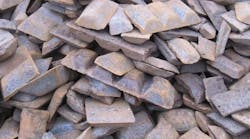Refractory coatings help foundries to protect bonded-sand cores and molds from producing defective castings, such as products with metal penetration, veining, erosion, and more. In the past, many foundry professionals also used coatings to cover imperfections in the molding media, but it is well known that even the best-designed coating cannot improve upon a bad core or mold, just as a fresh coat of paint can’t improve a piece of rotten wood. Foundries must look at refractory coatings as more than a way to “fix” an imperfect mold.
Controlling casting quality and increasing productivity are top priorities for foundries to become more competitive in a global casting market and coatings can help provide the solution. Addressing the issue of core/mold moisture can lead to productivity improvements and help to keep foundries competitive. Problems like poor core/mold density and moisture in the mold are difficult, if not impossible, to recognize and control, but advancements in coating technology now allow foundries to use engineered refractory coatings as a quality-control tool to help identify these issues.
As foundries look for products with a lighter environmental impact, water-based refractory coatings are replacing solvent-based products. When using these new products, it is critical to ensure no moisture remains in the mold before pouring metal into it. The presence of moisture can lead to a scrapped casting, but coatings that indicate when drying is complete can address this long-standing problem.
In 2004 Ashland introduced Velvaplast® ZW FDI coating, the first in a series of engineered refractory coatings that change color when dry, to indicate moisture loss. With ongoing improvements, a full line of color-changing coatings has been established for different binder systems and processes. Newer developments include not only variations of the Velvaplast brand but also color-changing versions of Ashland’s economical zircon-alternative coatings like Isocote® CAW 111 coating, which has excelled in flowcoating properties.
An additional application for refractory coatings that is sometimes overlooked is their use as a quality-control measure. Coating technologies that change color offer visual confirmation that the coating is dry. This confirmation also may indicate poor sand compaction in a core or mold, as these areas will absorb more moisture from the coating and take longer to dry. A visually obvious color change based on moisture content allows these new refractory coatings to act not only as a barrier between the metal and the mold, but also as a quality diagnostic.
Another way this technology can be used is to indicate when the coating had been over-diluted. If too much water has been added to the coating the color change will be slower than normal, due to the higher moisture content (assuming the coating drying oven is working properly and the operators are mindful of the drying cycle time.)
When multiple coats of a refractory coating are needed the color change can indicate to the operator when the first application is dry and it is acceptable to put on the next coating layer. This functionality can have a positive impact on moisture-related defects. Knowing when cores and molds are completely dry can translate into improved quality, productivity, reduced scrap, and reduced energy costs.
Different sands and binder systems can have different degrees of surface tension, so wetting and penetration using the same coating can vary depending on your specific core or mold-making parameters. These differences can change the amount of water pickup and thus the amount of time needed to dry a core or mold. The drying time or method (e.g., air-drying, torching, oven-drying, etc.) will not affect the color-change phenomena, only the time needed for different color-change phases to occur.
A trial application of Ashland’s new water-based coating technology led to improvements, like fewer scrap pieces and improved cycle times. The testing foundry used a highly refractive coating capable of getting into the the mold sections' tight grooves. This is imperative for good casting results. Prior attempts at spraying and brushing in these grooves produced poor quality castings, unacceptable to the foundry’s customers. Flowcoating these types of molds calls for a coating such as Ashland’s Velvaplast ZW-FDI that applies in a smooth, even layer with enough flow for excess coating to exit the mold upon draining.
A noticeable difference with using Ashland’s new color-change coating in the testing foundry’s application was a smoother coating with minimal runs and teardrops, solely because of the new coating’s rheology, not the color-change technology. The main difference in appearance was the new coating's initial coloring, a bright purple that shows up nicely on the dark colored molds.
Once the mold segments that were coated with the color-change coating were indexed to the drying station and drying began to take place, the initial benefits of this technology began to appear. As the moisture was driven off by the torpedo heaters the color of the coating on the mold changed from purple to bright yellow. Drying time was reduced by 50% because visual affirmation of drying could be made and no excess drying time was needed to confirm complete dryness.
With unprecedented pressure from foreign competition, high costs of raw materials, and environmental regulations, foundries need to find new ways to improve casting quality and productivity. As we look for process improvements in the typical areas of coremaking, molding, pouring, and cleaning, we also need to look at foundry consumables — more than we have done before.
Using Velvaplast ZW-FDI, or any of the water-based Velvaplast or Isocote color-change coatings, is an example of re-purposing conventional products that had been used only to produce a smooth surface finish on a casting, or to prevent penetration. Now, they can be understood as a quality-control tool that delivers several benefits. A decrease in energy costs, the surety of having a dry mold, and a reduction in rework costs are only a few of the benefits demonstrated by this advance in foundry consumable technology.









